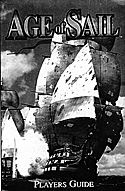 Game Design & Concepts: Jim Anderson, Joseph Hummel, Jim Rose, John Tiller
Game Design & Concepts: Jim Anderson, Joseph Hummel, Jim Rose, John Tiller
Programming: John Tiller
Game Graphics: Joe Amoral, Charles Kibler, Tim Kipp, Stephen Langmead
Number of Players: Solitaire (versus the computer) or 2-player (by modem as caller and host, or by direct cable/null modem).
Playing Time: 20 minutes to six hours or more
Complexity Level: Low
Packaging: Bookshelf storage box with full-color sleeve.
Scale: Each ship has its historical number of cannon and crew, and moves, fights, and suffers losses in "Real-Time" (NOT turn-based; that is, simultaneous, continuous movement, not you-move-I-move).
Maps & Playing Pieces: All components exist within the computer and appear on the screen. Units are individual ships, accruing damage to sails and hull by percentage and to crew and guns by number. Ships maneuver in eight directions on a featureless seascape.
RuleBook: 44-page softbound book, illustrated on each page. Technical support listed. Minimal historical information.
Scenarios: 4 instructional scenarios and 101 mainly historical scenarios.
Version Tested: 1.0
Format Tested: MS-DOS
Media: CD-ROM
System Requirements: Windows 3.1 or Windows 95, 100% IBM PC Compatibles, CPU 486DX33 minimum, 5MB minimum hard drive, 8MB minimum RAM, 2X (double-speed) CD-ROM required, Microsoft-compatible mouse, 256 Color SVGA supporting 640x480/800x600/1024x768 screen resolutions, all Windows-compatible sound cards.
Publisher: TalonSoft, Inc.
Publication Date: 1996
ISBN: 7-50560-00007-0
List Price: $49.95
Summary: Easy-to-learn game of late 18th to early 19th Century naval battles with good graphics. Real-time format makes small scenarios exciting but large fleet actions frustrating. Very large number of scenarios plus extensive ship library provide limitless replay value.
TalonSoft's Age of Sail is a relatively simple one- or two-player game in which players refight actions of the period 1775 to 1820. Although the game gives players relatively few variables to control, its real-time (instead of turn-based) system provides a high level of excitement.
Each player commands one or more ships ranging from 10-gun schooners to 130-gun ships of the line. Ships are rated for size, speed, and maneuverability, and incur damage to hull, rigging, guns, and crew (the first two by percentage, the latter by individual cannon and men).
For each ship, a player must decide in which of eight directions and how fast to travel, whether to use full, battle, or furled sails, what type of ammunition to load, whether to attempt grappling a ship that has collided with yours, and (optionally) when and at what target to fire.
Colorful Graphics
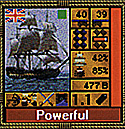 The colorful ship graphics show appropriate ship types (schooners, brigs, frigates, two- and three-deckers, etc.) and progressive effects of damage, such as holes in the sails and lost spars and topmasts. The "sea" upon which the ships sail is nondescript, showing gentle waves from the same direction regardless of wind and sea state. There are also no lighting effects, as if all battles take place at noon under an overcast sky (there are no shadows--not only does the sun never set on the British Empire, in Age of Sail it literally never sets on the Royal Navy, either).
The colorful ship graphics show appropriate ship types (schooners, brigs, frigates, two- and three-deckers, etc.) and progressive effects of damage, such as holes in the sails and lost spars and topmasts. The "sea" upon which the ships sail is nondescript, showing gentle waves from the same direction regardless of wind and sea state. There are also no lighting effects, as if all battles take place at noon under an overcast sky (there are no shadows--not only does the sun never set on the British Empire, in Age of Sail it literally never sets on the Royal Navy, either).
Large Color Screen Graphics (slow: 168K)
Though the gunfire sounds a bit feeble, other sound effects--the shouts and clashing cutlasses of a melee, the grinding and splintering of timbers in a collision--are good. These sound effects are important for drawing your attention to boarding actions and fouled ships in a portion of the battle you're not focused upon--never disable the sound effects in a battle of any size! Optional background music is tasteful and relatively unobtrusive.
Strong Point
The strongest point of Age of Sail is its extensive library of scenarios and ships, providing endless replay possibilities. The first fictional training scenario starts those new to the game with one ship; the next three progress to control of successively larger forces. All but a handful of the 101 other scenarios are historical, ranging from single-ship duels to fleet actions as large as The Saints and Trafalgar.
Each scenario includes a brief description of the action and its outcome, though in a couple of instances these are inaccurate. A player may also try a period campaign, where he or she begins as an Ensign commanding a single small vessel and attempts to work up to command of a fleet. The library includes over 2,000 ships covering the United States and every European navy of the period except (inexplicably) Venice, allowing construction of virtually any scenario imaginable.
At its heart, Age of Sail is a game of maneuver, with timing being the critical factor. When a ship turns is at least as important as which direction it turns. It takes some experience to master how much time is required to "lead" turns, particularly since the game accurately reflects the slower turning rates of larger ships. Regrettably, ships maneuver in only eight directions, depriving players an opportunity for a little greater finesse (and more realistically narrow fields of fire). All ships may point 45 degrees into the wind, which fails to reflect the relative advantage of fore-and-aft rigged vessels over square-riggers.
Surprisingly, for a game where maneuver is so important, crew quality does not affect rate of turn, nor does damage (until it becomes critical enough to virtually stop the ship).
The amount of sail hoisted affects both speed and the vulnerability of the rigging. Under full sail, a ship moves faster than under battle sails, but will incur relatively greater rigging damage from the same broadside.
Firing
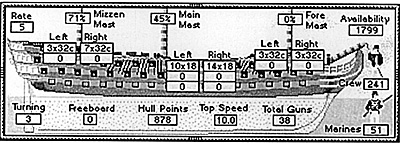 At right, damage indicator diagram.
At right, damage indicator diagram.
Firing consists of selecting a target within range and the arc of a loaded broadside and right-clicking on it. Broadsides may be fired up to 45 degrees ahead of or abaft (behind) the beam (perpendicular to the ship's direction of travel). The game will not allow you to waste a broadside on a target out of range.
Gunnery ranges are oversimplified, being determined solely by the ammunition employed: chain shot range is 40% of round shot, while grapeshot and double shot are 20% of ball. This is true regardless of whether the guns firing are 3-pounders or 32-pounders, which is tolerable albeit somewhat inaccurate. The effective range of carronades was only a couple hundred yards (which is accurately depicted), so they were essentially useless if a captain was unable to close the range (as David Porter admitted when he surrendered USS Essex to the British in 1814).
Curiously, although players decide whether or not to attempt grappling, and grappling is a necessary precursor for a melee, players have no other input into whether or not a boarding action takes place.
Clearly the designers equate a decision to grapple with intent to board, but this ignores the very real possibilities of either boarding without grappling or grappling to continue gunnery without maneuvering or desire to engage in hand-to-hand combat. However, this mechanic does have the welcome effect of making boarding actions much less common than in most games on this subject, where players precipitate melees with ahistorical frequency.
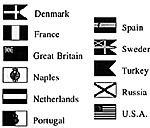 Crews are assigned one of five quality ratings from A (superior) to E (untrained). Other than functioning as targets, crew members play little or no role in the way players fight their ships. No allocation is necessary; crews can quite comfortably change sails, turn the ship, load one broadside, and fire the other all at the same time, without any of this taking any longer than if each action were taken individually.
Crews are assigned one of five quality ratings from A (superior) to E (untrained). Other than functioning as targets, crew members play little or no role in the way players fight their ships. No allocation is necessary; crews can quite comfortably change sails, turn the ship, load one broadside, and fire the other all at the same time, without any of this taking any longer than if each action were taken individually.
In one extreme example, grapeshot reduced the crew of an American sloop to exactly FIVE men, yet they were still able to do all these things simultaneously (granted, they were A quality, but we're talking Superman here!). In reality, ship's crews of the period were not large enough to do more than serve one broadside and turn the ship at the same time, with any additional actions taking longer and/or requiring some of the gun crews to assist.
Marines are tallied separately from crew members, but serve no purpose other than to engage in melees (and become the first casualties, i.e., serve as "cutlass-fodder"). This negates one of their primary historical purposes, serving as marksmen in the rigging (in which role a French marine mortally wounded Admiral Nelson at Trafalgar).
Disappointing ASpect
The most disappointing aspect of the game is the absence of any land or shallow water. Since many important battles of the period were fought where these factors were critical (Virginia Capes, the Nile, Copenhagen, and Lake Champlain, to name a few), this omission is regrettable. "[TalonSoft notes that its next naval game, Age of Ironclads, will include shorelines, and, as soon as the necessary programming is available, so will Age of Sail.]".
Although orders can be given to whole (scenario-assigned and inflexible) squadrons, attempting to control more than three or four ships is an experience in frustration. Fortunately, and contrary to what the documentation states, orders can be given while the game is "paused". This is vital in larger scenarios, where each player must either constantly stop the game to attend to more distant ships or end up with part of the fleet sailing blissfully along waiting for orders, because there is no provision for the computer's AI (Artificial Intelligence) to control only part of one side.
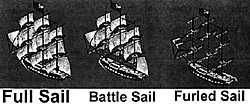 Ironically, this may reflect some of the difficulties of fighting under the old-style "Fighting Instructions", but such tactics were on their way out in the Royal Navy by the beginning of the period depicted in Age of Sail. A large Nelsonic battle, where individual captains are expected to exercise their judgement and initiative, is impossible in this game.
Ironically, this may reflect some of the difficulties of fighting under the old-style "Fighting Instructions", but such tactics were on their way out in the Royal Navy by the beginning of the period depicted in Age of Sail. A large Nelsonic battle, where individual captains are expected to exercise their judgement and initiative, is impossible in this game.
The computer's AI is a worthy opponent in smaller scenarios, though rather more limited in larger actions. Players wishing to test their mettle against one another will require two computers with either modem or cable connection. When our null modem connection proved balky, we tried a couple of scenarios using the same computer. Not surprisingly, this just doesn't work in a "real-time" game, unless you enjoy wrestling with your opponent for use of the mouse!
When this reviewer tried a period campaign, beginning as an Ensign and attempting to earn his way up to Admiral, the games soon lost their appeal due to the lack of context and static quality of the opposition. Although each encounter is prefaced by a statement giving you an objective, such as to defend a convoy, victory is determined solely by sinking or capturing enemy ships. Anything else results in a draw (and no "prestige" points).
"Also, as you advance due to gains in prestige, you are promoted to higher rank and a larger command, but the computer opponent never improved in the versions I played (1.0). [TalonSoft notes that version 1.04 is now available. If you purchased the earlier version, you can get all the latest updates by downloading them from their website: http://www.talonsoft.com. The latest version of Age of Sail features significant improvements to the campaign aspect of the game.]
"Those who prefer more accuracy in a game with this level of tactical detail may agree that it has major omissions and shortcomings. However, there is no denying that Age of Sail is a fun game to learn and play." Most players will enjoy sweating whether or not a ship will turn in time to avoid a collision or execute a rake, and the satisfaction of outmaneuvering your opponent (rather than outguessing him or her, as occurs in turn-based games such as Avalon Hill's Wooden Ships and Iron Men) is high.
This game may be less satisfying to those desiring an accurate simulation of sailing ship actions in the Napoleonic era, but players will find Age of Sail an enjoyable diversion with tremendous replay value. "[TalonSoft designers note that they never claimed AoS to be the ultimate simulation of naval warfare in this era. It is supposed to be a fun game that includes many historically correct factors and information. They feel it successfully captures the essence of the period without forcing the players to engage in micro-management or get bogged down in minutiae.]"
Back to Table of Contents -- Napoleon #8
Back to Napoleon List of Issues
Back to MagWeb Master Magazine List
© Copyright 1997 by Emperor's Press.
This article appears in MagWeb (Magazine Web) on the Internet World Wide Web.
The full text and graphics from other military history magazines and gaming magazines are available at http://www.magweb.com